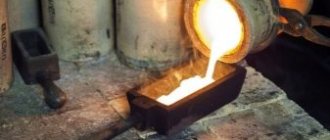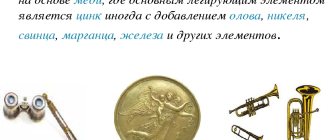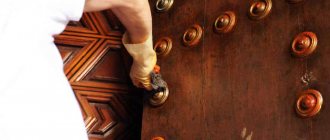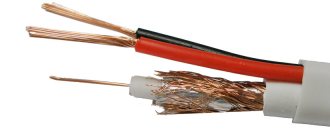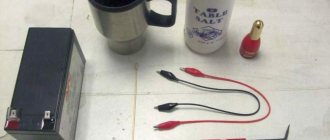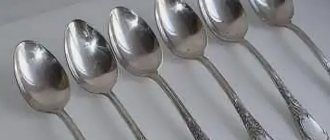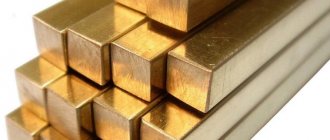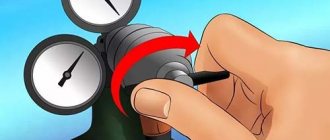Copper alloys have a similar chemical composition, so the external characteristics of bronze and brass are the same. This creates difficulties when it comes to distinguishing between metals. The main reason for the difficulty in identifying a specific alloy is the large number of grades and modifications of compounds. Color often does not immediately reveal the type of alloy, so other ways to distinguish between brass and bronze are needed. Typically, owners need to determine the alloy when selling scrap to the secondary market. Our company accepts brass shavings and bronze scrap metal on favorable terms. We will evaluate the scrap free of charge to accurately identify the composition and grade of the metal, as well as maximum cash payments to customers.
How to distinguish bronze from brass at home by appearance?
Bronze is an alloy of copper and tin; small amounts of other additives may be present. Brass, in turn, is an alloy of copper and zinc. The ancient Romans began to use it, but then they introduced zinc ore into molten copper. The result was an excellent metal from which sculptures and statues were made. Externally, the metals are indeed very similar, but a specialist with the naked eye will be able to distinguish these two alloys. The most interesting thing is that in the 19th century, counterfeit coins were even made. After all, the color of the metal corresponds to gold.
Metal containing tin is more ductile, so it is used for the manufacture of forged parts. In addition, it is characterized by high strength and hardness. Brass is also quite ductile, but more brittle. Derived from the word berenj, it means copper. It is not used where abrasion resistance is needed.
In fact, the two metals are very similar, since the composition is predominantly copper. But impurities completely determine their properties. A mixture with tin is a favorite material of sculptors due to its durability and wear resistance. Zinc alloy is less durable and wears out quickly.
Sculptures
Chemical analysis
You can check the presence of alloys in the metal in a certified laboratory. There are institutions that perform analysis on the day the sample is received. Laboratory research methods:
- Spectral.
- "Wet chemistry".
- On an electron microscope.
- Steelscoping of welded joints.
The instruments are used to perform spectral and chemical analysis of the metal. Specialists test the material for tension, bending and hardness. By measuring the parameters, the type of metal is determined. The result is sent by email.
How does bronze differ from brass in composition?
Characteristic differences between these two metals should only be expected if they are fairly pure. But the fact is that now there are a huge number of varieties of both brass and bronze. Very often, tin is not added to bronze at all and a mixture of aluminum, beryllium and magnesium is introduced as an alloying element. Thanks to this, the color of the metal also changes greatly. If the tin content in the metal is high enough, reaching 40%, then its color can fluctuate up to white. That is, it resembles steel.
At the same time, it gives only a light golden tint. In general, the metal turns out almost silvery. Regarding brass, if it contains a large amount of zinc, then the color of the metal is the same as gold. Quite often this material is used to make a variety of costume jewelry and cheap jewelry. Such jewelry looks quite organic, nice, and at the same time has a low price.
Fitting
Properties of alloys
The chemical composition of alloys directly determines their characteristics. The difference in composition will allow you to distinguish between brass and bronze.
It is important to know that bronze alloys have high strength, ductility and resistance to external influences. Their properties cannot be affected by carbon dioxide and salt solutions or sea water. The material has excellent corrosion resistance and is easy to solder and weld.
The presence of alloying additives has a direct impact on the technical properties of alloys. The inclusion of manganese and silicon in the composition reduces the heat resistance of the material; nickel and iron reduce electrical conductivity and grain size. The addition of zinc, phosphorus and lead has a positive effect on anti-friction properties.
The list of disadvantages of bronze should include:
- fragility;
- low hardness;
- high specific gravity.
In addition, bronze alloys are more expensive to produce than aluminum.
The properties of brass are similar to those of bronze alloys, but it conducts heat and electricity less well and is less resistant to corrosion, especially at high temperatures.
The inclusion of tin in the alloy can significantly improve the properties of the material. Lead brass is easy to process on automatic cutting machines. The material melts well, has excellent fluidity and low shrinkage during casting. The disadvantages of these alloys include the tendency to form shells during the production of parts by casting. The inclusion of special fluxes in the raw materials and the placement of a carbon layer in the furnace allows us to ensure product quality.
It is important to take into account that the main alloying component in bronze is tin, and zinc is added to brass. For this reason, the corrosion resistance of bronze is higher than that of brass.
How to distinguish bronze from brass using a magnet?
- When it comes to a variety of alloys, it can be quite difficult to distinguish bronze from brass, because they can be almost identical. Many experts believe that bronze is heavier than brass. This is indeed due to the content of tin and lead, which are quite heavy.
- Brass is much lighter due to the presence of zinc. You can conduct a few simple experiments to find out which metal is in front of you. Bronze is almost always magnetic due to the presence of tin.
- That is, if you apply a strong enough magnet, you will see significant magnetization. The higher the tin content in the metal, the stronger the magnetization. Brass, in turn, does not exhibit magnetic properties, that is, when a magnet is placed, it does not stick at all.
Material processing
Ways to distinguish bronze from brass by heating, filing
The type of metal can be determined by heating. However, this method is only suitable if you have your own workshop or garage. The thing is, you will need a cutting torch for this experiment. Heat a sample of the proposed material using a gas burner to 600 degrees.
If you try to bend it after this, the bronze will easily break. When heated, it becomes quite brittle and does not bend. Brass, in turn, bends very well and melts easily. This is due to the presence of zinc in the composition. This material is more plastic and pliable when heated than tin.
To determine the alloy, many people advise taking a hacksaw, filing the product a little, and paying attention to the quality of the chips that are formed. The tin metal is sawn into tiny flakes that are brittle. That is, as a result you will get fine dust that does not quite look like shavings. This is due to the fact that bronze contains a lot of tin, which crumbles and breaks off from the main piece of metal. Brass is sawn in a completely different way, forming layers, as well as characteristic ornate shavings.
Old dishes
Scratch and listen
This method seems exotic, but after practicing on known samples, you will learn to reliably identify lead brass. This method requires a tool that will leave a scratch on the surface of the brass. It is convenient to work with a beak-shaped tool. The scratching stick can be turned out of a hacksaw blade and wrapped with electrical tape to form a handle. The scratching technique is simple: press down on the tool and make an even scratch across the surface of the brass, listening to the sound when scratching. Lead brass will squeak and scratch the bottom of the step. The cutter glides smoothly on lead-free brass.
Laboratory methods to distinguish brass from bronze
All these methods are suitable only if you want to distinguish standard brass from bronze, which contains a maximum of tin, as well as zinc. Otherwise, the tests will be quite difficult, due to the fact that there is tin-free bronze, which does not contain tin at all. Accordingly, the color of the metal will be completely different. Therefore, it is quite difficult to find out the composition of the metal at home. In laboratory conditions, the composition is most often determined using spectrographic and refractometric analysis.
There are tests with nitric acid. To carry out the tests, pour some alloy shavings into the container and fill it with 50% nitric acid. The mixture of test tubes needs to be warmed up a little. In a test tube with brass, the alloy will dissolve and you will get a clear solution. In the container of the alloy with tin there will be a white precipitate of its salts.
Antiques
Iodine test
You can check the authenticity of the metal using an iodine solution purchased at a pharmacy. A drop of iodine is applied to the surface and left for several seconds. Iodine will not harm noble metals - gold, platinum, silver. If the color of a drop of iodine does not change, and after removing it with a napkin, no traces or stains remain, this indicates the authenticity of the metal. If darkening is visible at the place of the drop, then this is a low-quality alloy or an outright fake.
Iodine testing of gold
Differences in the nature of the fracture and evaluation of the finished product
Many people will even say, why bother figuring out whether it’s brass or copper if the two alloys look almost the same? But the fact is that this is important for many, in particular for people who will be involved in making some kind of sculptures or melting them down. Accordingly, very often a distinction is required if you are going to sell metal for scrap.
The fact is that brass is cheaper than bronze, so at a metal collection point they can simply deceive you and offer you a smaller amount. If the weight is small, then the losses will be insignificant, but if you have a fairly large amount of goods, then you will lose a decent amount of money. It is worth noting that there is no need to conduct tests, just look at the finished products. Brass is almost never used in shipping.
Locksmith tool
This material is destroyed when exposed to sea salt water, so compasses and some parts in shipbuilding are used exclusively in bronze. Therefore, if they are trying to deceive you, insist on checking the product, or contact a certified center. They usually have collection points as well as small compact laboratories. They can conduct a quick, simple analysis and analyze the product using laboratory equipment.
It is quite easy to distinguish between metals when viewing the fracture site. Brass breaks in fairly small grains, bronze breaks off in large pieces and has a coarse grain. At the same time, the color of the bronze fracture has a reddish tint; if it is brass, then it has a whitish or yellowish tint.
Accessories skull
Unfortunately, these methods cannot be used at home due to the lack of laboratory equipment. Magnet and chip tests are available for home users. They are also very informative.
Conclusion
People involved in the collection, delivery and acceptance of non-ferrous scrap need to know and be able to distinguish externally similar non-ferrous metals. The ability to determine can pay off well, since brass at collection points costs almost half as much as first-grade copper.
If the found object is small, you can determine it yourself. If the amount of scrap is large, you can resort to the help of tools or an analyzer that is rented.
If you decide to hand over non-ferrous scrap metal, make sure that the collection point has a license for this.
You can see how to clean these non-ferrous metals before delivery in this video:
